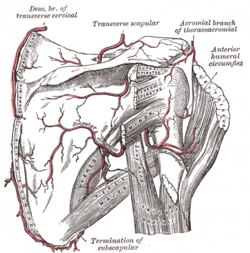Subscapular artery
The subscapular artery, the largest branch of the axillary artery, arises from the third part of the axillary artery at the lower border of the subscapularis muscle, which it follows to the inferior angle of the scapula, where it anastomoses with the lateral thoracic and intercostal arteries, and with the descending branch of the dorsal scapular artery (a.k.a. deep branch of the transverse cervical artery if it arises from the cervical trunk), and ends in the neighboring muscles.
| Subscapular artery | |
|---|---|
Axillary artery and its branches, including subscapular artery - anterior view of right upper limb and thorax. | |
 The scapular and circumflex arteries. | |
| Details | |
| Source | Axillary artery |
| Branches | circumflex scapular artery, thoracodorsal artery |
| Supplies | Latissimus dorsi |
| Identifiers | |
| Latin | arteria subscapularis |
| TA | A12.2.09.013 |
| FMA | 22677 |
| Anatomical terminology | |
About 4 cm from its origin it gives off two branches, first the scapular circumflex artery and then the thoracodorsal artery.
From the thoracodorsal artery it supplies latissimus dorsi, while the scapular circumflex artery participates in the scapular anastamosis. It terminates in an anastomosis with the dorsal scapular artery.[1]
Additional Images
- Subscapular artery
References
- Moore, Keith (2014). Clinically Oriented Anatomy Seventh Edition. Wolters Kluwer. pp. 716–717. ISBN 978-1-4511-1945-9.
This article incorporates text in the public domain from page 588 of the 20th edition of Gray's Anatomy (1918)
External links
- Illustration at microsurgeon.org
- Photo at mvm.ed.ac.uk
- lesson3axillaryart&vein at The Anatomy Lesson by Wesley Norman (Georgetown University)